Critique of Article on Music Festival Attendees' Illicit Drug Use
VerifiedAdded on 2022/12/30
|8
|1949
|1
AI Summary
This paper critiques an article on the knowledge and practices of youths attending music festivals regarding drug testing services on site. The specific areas of critique include authorship, research objective, research methods, research design, and limitations.
Contribute Materials
Your contribution can guide someone’s learning journey. Share your
documents today.

Running head: Nursing 1
Nursing
by
Course:
Tutor:
University:
Department:
Date:
Nursing
by
Course:
Tutor:
University:
Department:
Date:
Secure Best Marks with AI Grader
Need help grading? Try our AI Grader for instant feedback on your assignments.
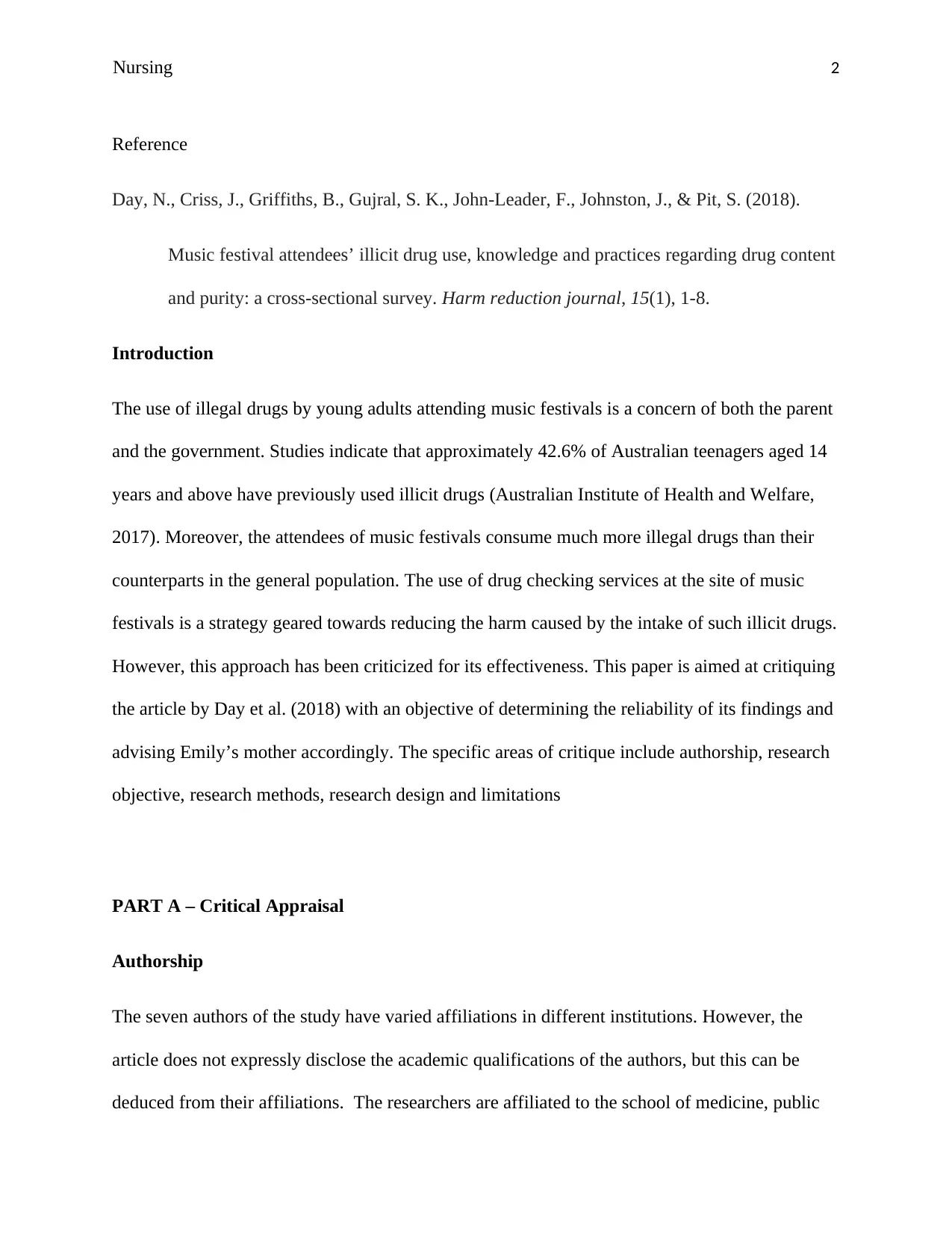
Nursing 2
Reference
Day, N., Criss, J., Griffiths, B., Gujral, S. K., John-Leader, F., Johnston, J., & Pit, S. (2018).
Music festival attendees’ illicit drug use, knowledge and practices regarding drug content
and purity: a cross-sectional survey. Harm reduction journal, 15(1), 1-8.
Introduction
The use of illegal drugs by young adults attending music festivals is a concern of both the parent
and the government. Studies indicate that approximately 42.6% of Australian teenagers aged 14
years and above have previously used illicit drugs (Australian Institute of Health and Welfare,
2017). Moreover, the attendees of music festivals consume much more illegal drugs than their
counterparts in the general population. The use of drug checking services at the site of music
festivals is a strategy geared towards reducing the harm caused by the intake of such illicit drugs.
However, this approach has been criticized for its effectiveness. This paper is aimed at critiquing
the article by Day et al. (2018) with an objective of determining the reliability of its findings and
advising Emily’s mother accordingly. The specific areas of critique include authorship, research
objective, research methods, research design and limitations
PART A – Critical Appraisal
Authorship
The seven authors of the study have varied affiliations in different institutions. However, the
article does not expressly disclose the academic qualifications of the authors, but this can be
deduced from their affiliations. The researchers are affiliated to the school of medicine, public
Reference
Day, N., Criss, J., Griffiths, B., Gujral, S. K., John-Leader, F., Johnston, J., & Pit, S. (2018).
Music festival attendees’ illicit drug use, knowledge and practices regarding drug content
and purity: a cross-sectional survey. Harm reduction journal, 15(1), 1-8.
Introduction
The use of illegal drugs by young adults attending music festivals is a concern of both the parent
and the government. Studies indicate that approximately 42.6% of Australian teenagers aged 14
years and above have previously used illicit drugs (Australian Institute of Health and Welfare,
2017). Moreover, the attendees of music festivals consume much more illegal drugs than their
counterparts in the general population. The use of drug checking services at the site of music
festivals is a strategy geared towards reducing the harm caused by the intake of such illicit drugs.
However, this approach has been criticized for its effectiveness. This paper is aimed at critiquing
the article by Day et al. (2018) with an objective of determining the reliability of its findings and
advising Emily’s mother accordingly. The specific areas of critique include authorship, research
objective, research methods, research design and limitations
PART A – Critical Appraisal
Authorship
The seven authors of the study have varied affiliations in different institutions. However, the
article does not expressly disclose the academic qualifications of the authors, but this can be
deduced from their affiliations. The researchers are affiliated to the school of medicine, public
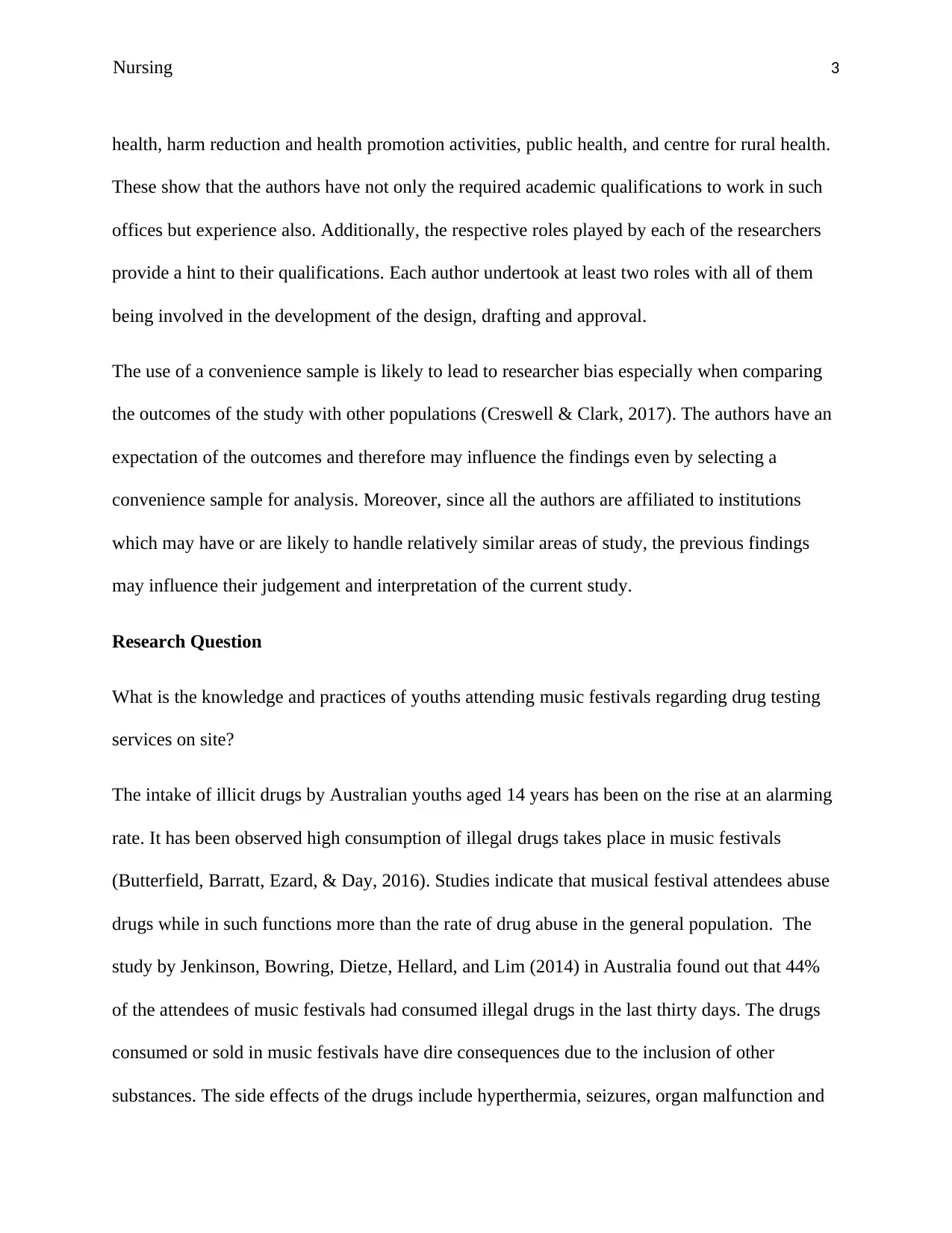
Nursing 3
health, harm reduction and health promotion activities, public health, and centre for rural health.
These show that the authors have not only the required academic qualifications to work in such
offices but experience also. Additionally, the respective roles played by each of the researchers
provide a hint to their qualifications. Each author undertook at least two roles with all of them
being involved in the development of the design, drafting and approval.
The use of a convenience sample is likely to lead to researcher bias especially when comparing
the outcomes of the study with other populations (Creswell & Clark, 2017). The authors have an
expectation of the outcomes and therefore may influence the findings even by selecting a
convenience sample for analysis. Moreover, since all the authors are affiliated to institutions
which may have or are likely to handle relatively similar areas of study, the previous findings
may influence their judgement and interpretation of the current study.
Research Question
What is the knowledge and practices of youths attending music festivals regarding drug testing
services on site?
The intake of illicit drugs by Australian youths aged 14 years has been on the rise at an alarming
rate. It has been observed high consumption of illegal drugs takes place in music festivals
(Butterfield, Barratt, Ezard, & Day, 2016). Studies indicate that musical festival attendees abuse
drugs while in such functions more than the rate of drug abuse in the general population. The
study by Jenkinson, Bowring, Dietze, Hellard, and Lim (2014) in Australia found out that 44%
of the attendees of music festivals had consumed illegal drugs in the last thirty days. The drugs
consumed or sold in music festivals have dire consequences due to the inclusion of other
substances. The side effects of the drugs include hyperthermia, seizures, organ malfunction and
health, harm reduction and health promotion activities, public health, and centre for rural health.
These show that the authors have not only the required academic qualifications to work in such
offices but experience also. Additionally, the respective roles played by each of the researchers
provide a hint to their qualifications. Each author undertook at least two roles with all of them
being involved in the development of the design, drafting and approval.
The use of a convenience sample is likely to lead to researcher bias especially when comparing
the outcomes of the study with other populations (Creswell & Clark, 2017). The authors have an
expectation of the outcomes and therefore may influence the findings even by selecting a
convenience sample for analysis. Moreover, since all the authors are affiliated to institutions
which may have or are likely to handle relatively similar areas of study, the previous findings
may influence their judgement and interpretation of the current study.
Research Question
What is the knowledge and practices of youths attending music festivals regarding drug testing
services on site?
The intake of illicit drugs by Australian youths aged 14 years has been on the rise at an alarming
rate. It has been observed high consumption of illegal drugs takes place in music festivals
(Butterfield, Barratt, Ezard, & Day, 2016). Studies indicate that musical festival attendees abuse
drugs while in such functions more than the rate of drug abuse in the general population. The
study by Jenkinson, Bowring, Dietze, Hellard, and Lim (2014) in Australia found out that 44%
of the attendees of music festivals had consumed illegal drugs in the last thirty days. The drugs
consumed or sold in music festivals have dire consequences due to the inclusion of other
substances. The side effects of the drugs include hyperthermia, seizures, organ malfunction and
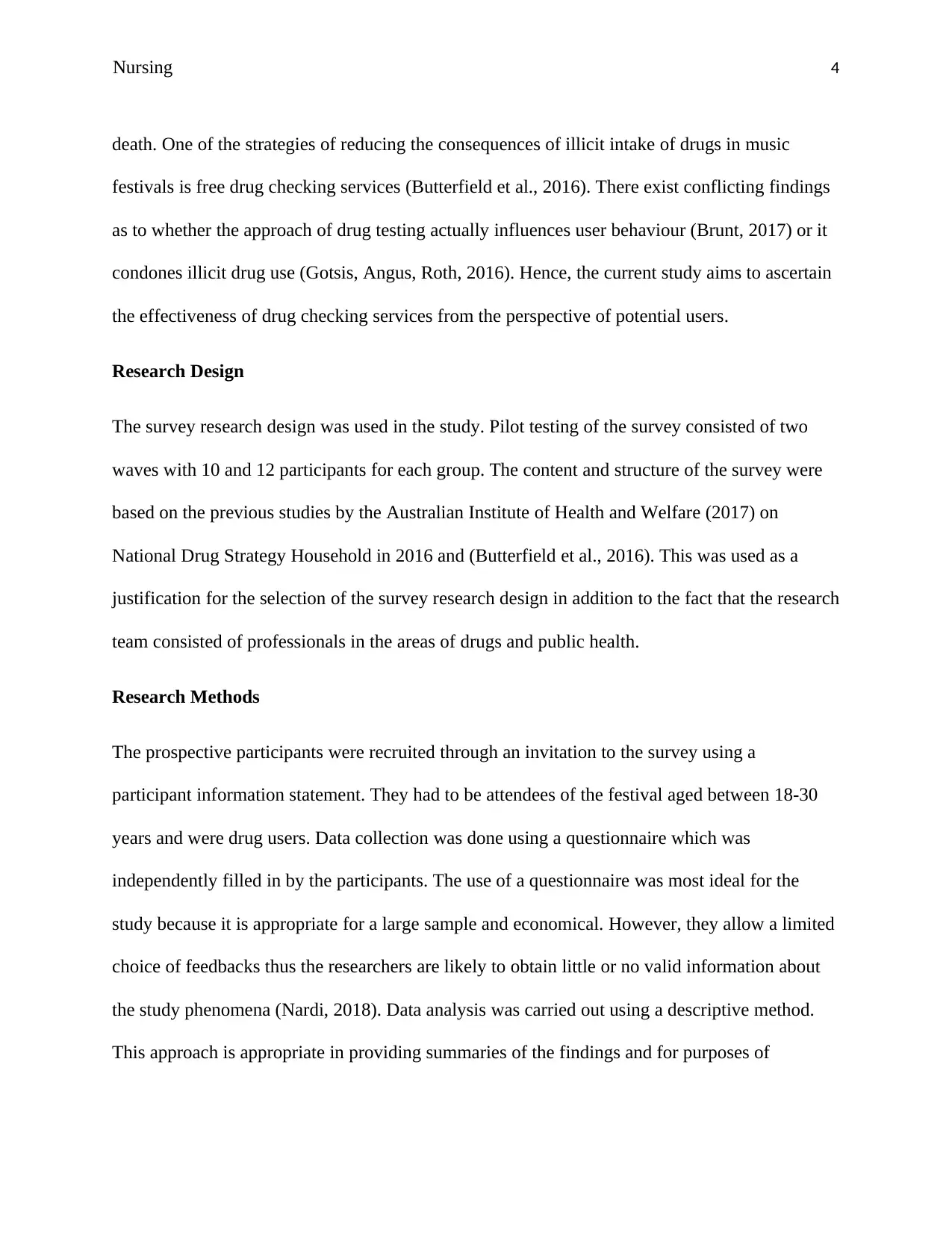
Nursing 4
death. One of the strategies of reducing the consequences of illicit intake of drugs in music
festivals is free drug checking services (Butterfield et al., 2016). There exist conflicting findings
as to whether the approach of drug testing actually influences user behaviour (Brunt, 2017) or it
condones illicit drug use (Gotsis, Angus, Roth, 2016). Hence, the current study aims to ascertain
the effectiveness of drug checking services from the perspective of potential users.
Research Design
The survey research design was used in the study. Pilot testing of the survey consisted of two
waves with 10 and 12 participants for each group. The content and structure of the survey were
based on the previous studies by the Australian Institute of Health and Welfare (2017) on
National Drug Strategy Household in 2016 and (Butterfield et al., 2016). This was used as a
justification for the selection of the survey research design in addition to the fact that the research
team consisted of professionals in the areas of drugs and public health.
Research Methods
The prospective participants were recruited through an invitation to the survey using a
participant information statement. They had to be attendees of the festival aged between 18-30
years and were drug users. Data collection was done using a questionnaire which was
independently filled in by the participants. The use of a questionnaire was most ideal for the
study because it is appropriate for a large sample and economical. However, they allow a limited
choice of feedbacks thus the researchers are likely to obtain little or no valid information about
the study phenomena (Nardi, 2018). Data analysis was carried out using a descriptive method.
This approach is appropriate in providing summaries of the findings and for purposes of
death. One of the strategies of reducing the consequences of illicit intake of drugs in music
festivals is free drug checking services (Butterfield et al., 2016). There exist conflicting findings
as to whether the approach of drug testing actually influences user behaviour (Brunt, 2017) or it
condones illicit drug use (Gotsis, Angus, Roth, 2016). Hence, the current study aims to ascertain
the effectiveness of drug checking services from the perspective of potential users.
Research Design
The survey research design was used in the study. Pilot testing of the survey consisted of two
waves with 10 and 12 participants for each group. The content and structure of the survey were
based on the previous studies by the Australian Institute of Health and Welfare (2017) on
National Drug Strategy Household in 2016 and (Butterfield et al., 2016). This was used as a
justification for the selection of the survey research design in addition to the fact that the research
team consisted of professionals in the areas of drugs and public health.
Research Methods
The prospective participants were recruited through an invitation to the survey using a
participant information statement. They had to be attendees of the festival aged between 18-30
years and were drug users. Data collection was done using a questionnaire which was
independently filled in by the participants. The use of a questionnaire was most ideal for the
study because it is appropriate for a large sample and economical. However, they allow a limited
choice of feedbacks thus the researchers are likely to obtain little or no valid information about
the study phenomena (Nardi, 2018). Data analysis was carried out using a descriptive method.
This approach is appropriate in providing summaries of the findings and for purposes of
Secure Best Marks with AI Grader
Need help grading? Try our AI Grader for instant feedback on your assignments.
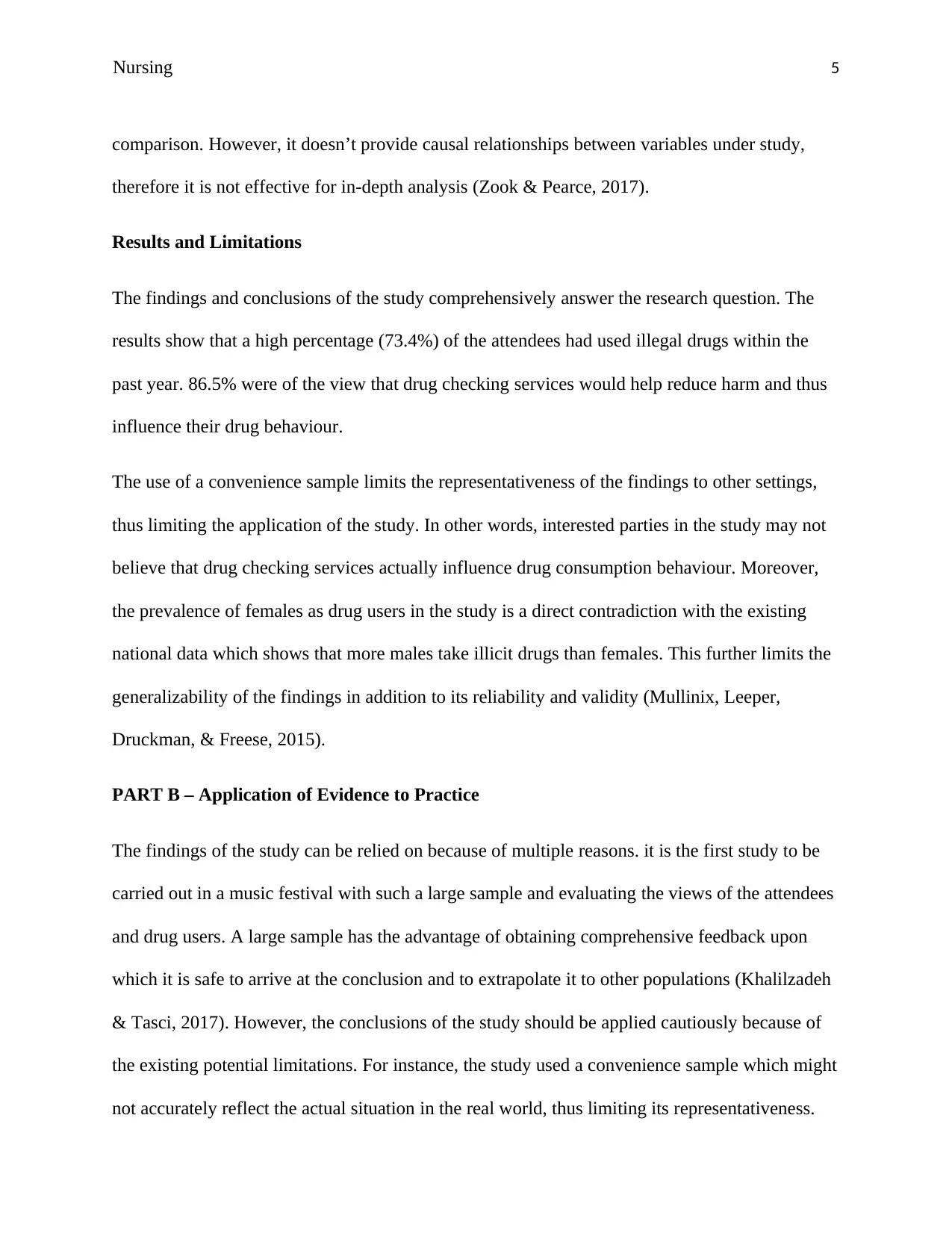
Nursing 5
comparison. However, it doesn’t provide causal relationships between variables under study,
therefore it is not effective for in-depth analysis (Zook & Pearce, 2017).
Results and Limitations
The findings and conclusions of the study comprehensively answer the research question. The
results show that a high percentage (73.4%) of the attendees had used illegal drugs within the
past year. 86.5% were of the view that drug checking services would help reduce harm and thus
influence their drug behaviour.
The use of a convenience sample limits the representativeness of the findings to other settings,
thus limiting the application of the study. In other words, interested parties in the study may not
believe that drug checking services actually influence drug consumption behaviour. Moreover,
the prevalence of females as drug users in the study is a direct contradiction with the existing
national data which shows that more males take illicit drugs than females. This further limits the
generalizability of the findings in addition to its reliability and validity (Mullinix, Leeper,
Druckman, & Freese, 2015).
PART B – Application of Evidence to Practice
The findings of the study can be relied on because of multiple reasons. it is the first study to be
carried out in a music festival with such a large sample and evaluating the views of the attendees
and drug users. A large sample has the advantage of obtaining comprehensive feedback upon
which it is safe to arrive at the conclusion and to extrapolate it to other populations (Khalilzadeh
& Tasci, 2017). However, the conclusions of the study should be applied cautiously because of
the existing potential limitations. For instance, the study used a convenience sample which might
not accurately reflect the actual situation in the real world, thus limiting its representativeness.
comparison. However, it doesn’t provide causal relationships between variables under study,
therefore it is not effective for in-depth analysis (Zook & Pearce, 2017).
Results and Limitations
The findings and conclusions of the study comprehensively answer the research question. The
results show that a high percentage (73.4%) of the attendees had used illegal drugs within the
past year. 86.5% were of the view that drug checking services would help reduce harm and thus
influence their drug behaviour.
The use of a convenience sample limits the representativeness of the findings to other settings,
thus limiting the application of the study. In other words, interested parties in the study may not
believe that drug checking services actually influence drug consumption behaviour. Moreover,
the prevalence of females as drug users in the study is a direct contradiction with the existing
national data which shows that more males take illicit drugs than females. This further limits the
generalizability of the findings in addition to its reliability and validity (Mullinix, Leeper,
Druckman, & Freese, 2015).
PART B – Application of Evidence to Practice
The findings of the study can be relied on because of multiple reasons. it is the first study to be
carried out in a music festival with such a large sample and evaluating the views of the attendees
and drug users. A large sample has the advantage of obtaining comprehensive feedback upon
which it is safe to arrive at the conclusion and to extrapolate it to other populations (Khalilzadeh
& Tasci, 2017). However, the conclusions of the study should be applied cautiously because of
the existing potential limitations. For instance, the study used a convenience sample which might
not accurately reflect the actual situation in the real world, thus limiting its representativeness.
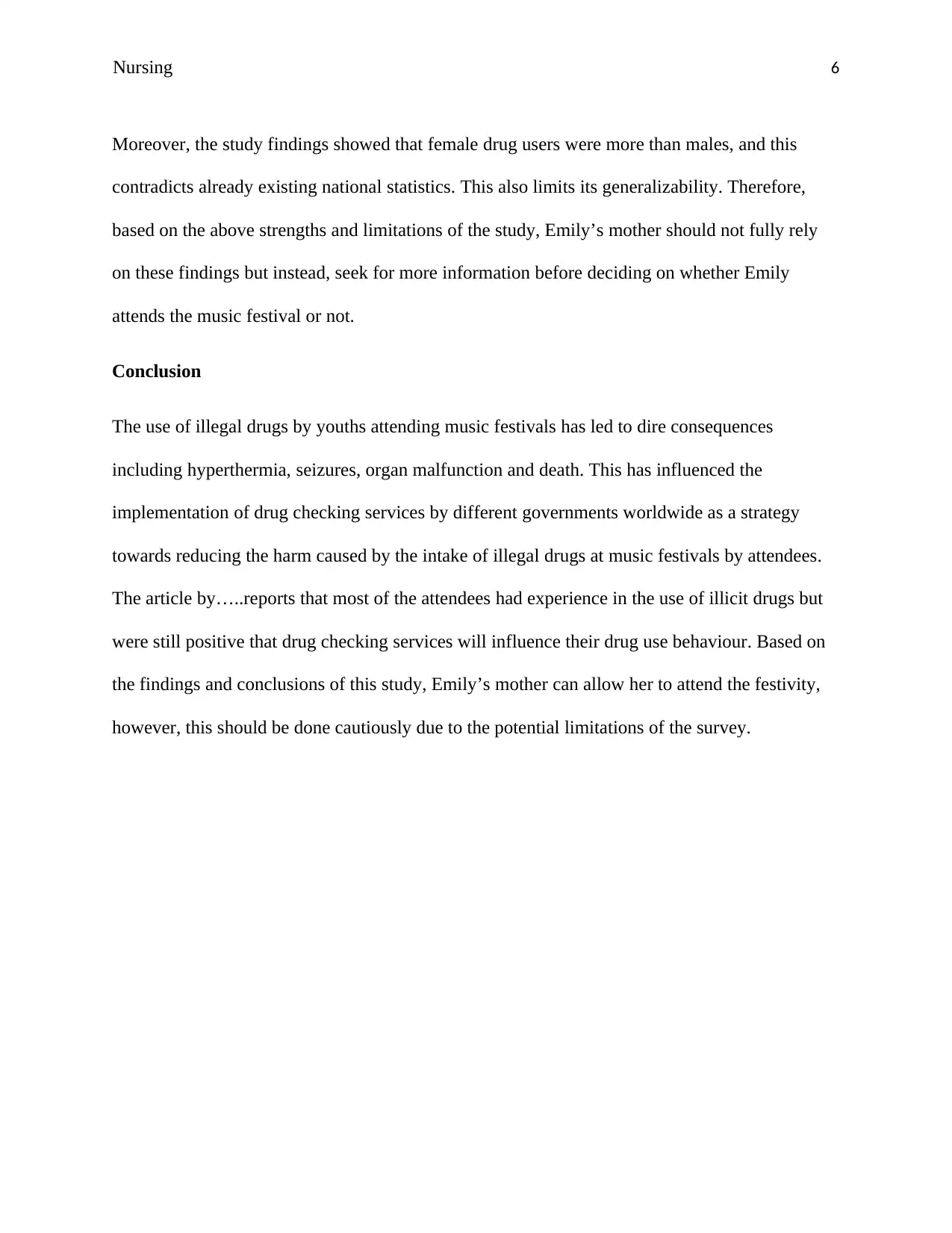
Nursing 6
Moreover, the study findings showed that female drug users were more than males, and this
contradicts already existing national statistics. This also limits its generalizability. Therefore,
based on the above strengths and limitations of the study, Emily’s mother should not fully rely
on these findings but instead, seek for more information before deciding on whether Emily
attends the music festival or not.
Conclusion
The use of illegal drugs by youths attending music festivals has led to dire consequences
including hyperthermia, seizures, organ malfunction and death. This has influenced the
implementation of drug checking services by different governments worldwide as a strategy
towards reducing the harm caused by the intake of illegal drugs at music festivals by attendees.
The article by…..reports that most of the attendees had experience in the use of illicit drugs but
were still positive that drug checking services will influence their drug use behaviour. Based on
the findings and conclusions of this study, Emily’s mother can allow her to attend the festivity,
however, this should be done cautiously due to the potential limitations of the survey.
Moreover, the study findings showed that female drug users were more than males, and this
contradicts already existing national statistics. This also limits its generalizability. Therefore,
based on the above strengths and limitations of the study, Emily’s mother should not fully rely
on these findings but instead, seek for more information before deciding on whether Emily
attends the music festival or not.
Conclusion
The use of illegal drugs by youths attending music festivals has led to dire consequences
including hyperthermia, seizures, organ malfunction and death. This has influenced the
implementation of drug checking services by different governments worldwide as a strategy
towards reducing the harm caused by the intake of illegal drugs at music festivals by attendees.
The article by…..reports that most of the attendees had experience in the use of illicit drugs but
were still positive that drug checking services will influence their drug use behaviour. Based on
the findings and conclusions of this study, Emily’s mother can allow her to attend the festivity,
however, this should be done cautiously due to the potential limitations of the survey.
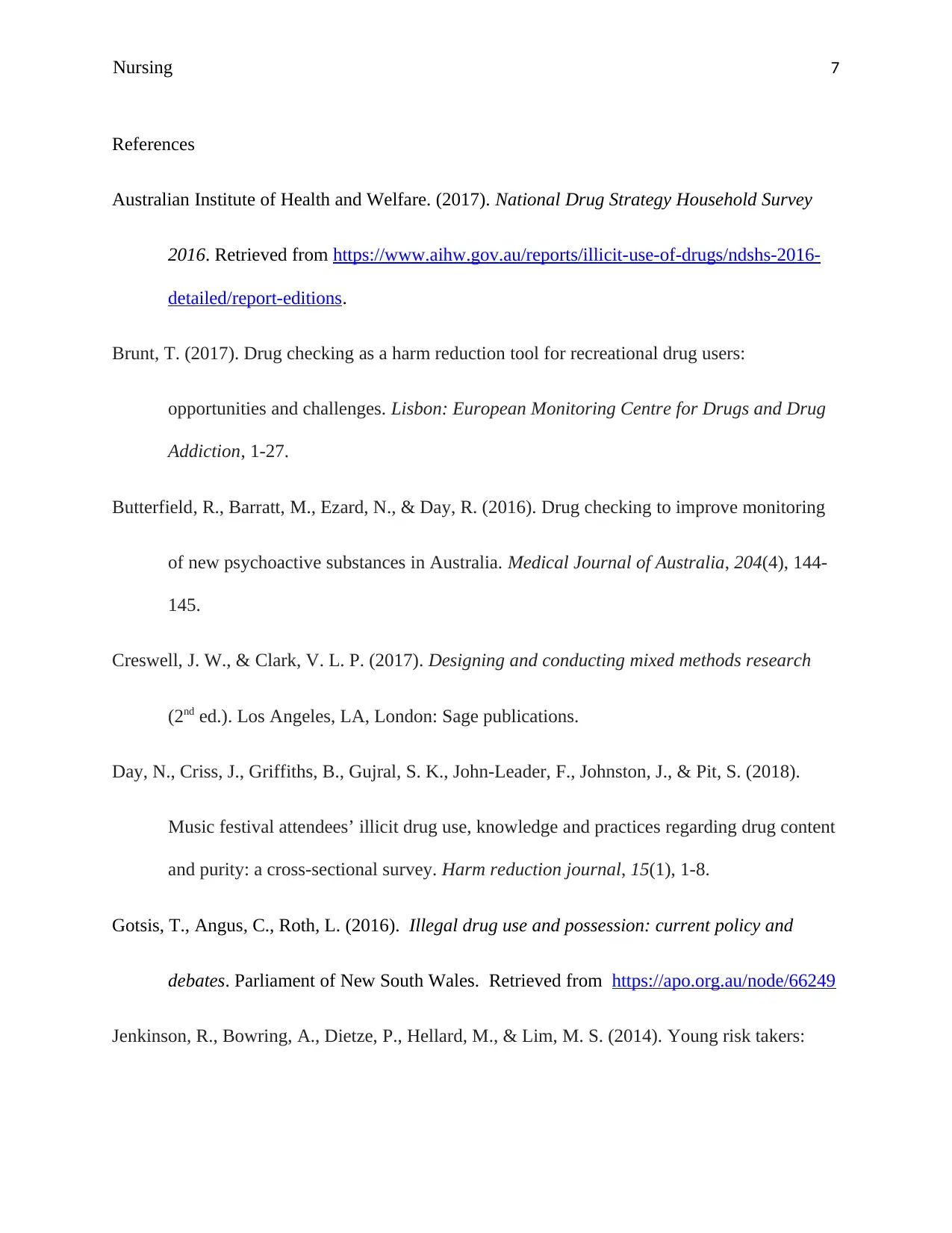
Nursing 7
References
Australian Institute of Health and Welfare. (2017). National Drug Strategy Household Survey
2016. Retrieved from https://www.aihw.gov.au/reports/illicit-use-of-drugs/ndshs-2016-
detailed/report-editions.
Brunt, T. (2017). Drug checking as a harm reduction tool for recreational drug users:
opportunities and challenges. Lisbon: European Monitoring Centre for Drugs and Drug
Addiction, 1-27.
Butterfield, R., Barratt, M., Ezard, N., & Day, R. (2016). Drug checking to improve monitoring
of new psychoactive substances in Australia. Medical Journal of Australia, 204(4), 144-
145.
Creswell, J. W., & Clark, V. L. P. (2017). Designing and conducting mixed methods research
(2nd ed.). Los Angeles, LA, London: Sage publications.
Day, N., Criss, J., Griffiths, B., Gujral, S. K., John-Leader, F., Johnston, J., & Pit, S. (2018).
Music festival attendees’ illicit drug use, knowledge and practices regarding drug content
and purity: a cross-sectional survey. Harm reduction journal, 15(1), 1-8.
Gotsis, T., Angus, C., Roth, L. (2016). Illegal drug use and possession: current policy and
debates. Parliament of New South Wales. Retrieved from https://apo.org.au/node/66249
Jenkinson, R., Bowring, A., Dietze, P., Hellard, M., & Lim, M. S. (2014). Young risk takers:
References
Australian Institute of Health and Welfare. (2017). National Drug Strategy Household Survey
2016. Retrieved from https://www.aihw.gov.au/reports/illicit-use-of-drugs/ndshs-2016-
detailed/report-editions.
Brunt, T. (2017). Drug checking as a harm reduction tool for recreational drug users:
opportunities and challenges. Lisbon: European Monitoring Centre for Drugs and Drug
Addiction, 1-27.
Butterfield, R., Barratt, M., Ezard, N., & Day, R. (2016). Drug checking to improve monitoring
of new psychoactive substances in Australia. Medical Journal of Australia, 204(4), 144-
145.
Creswell, J. W., & Clark, V. L. P. (2017). Designing and conducting mixed methods research
(2nd ed.). Los Angeles, LA, London: Sage publications.
Day, N., Criss, J., Griffiths, B., Gujral, S. K., John-Leader, F., Johnston, J., & Pit, S. (2018).
Music festival attendees’ illicit drug use, knowledge and practices regarding drug content
and purity: a cross-sectional survey. Harm reduction journal, 15(1), 1-8.
Gotsis, T., Angus, C., Roth, L. (2016). Illegal drug use and possession: current policy and
debates. Parliament of New South Wales. Retrieved from https://apo.org.au/node/66249
Jenkinson, R., Bowring, A., Dietze, P., Hellard, M., & Lim, M. S. (2014). Young risk takers:
Paraphrase This Document
Need a fresh take? Get an instant paraphrase of this document with our AI Paraphraser

Nursing 8
alcohol, illicit drugs, and sexual practices among a sample of music festival
attendees. Journal of sexually transmitted diseases, 2014, 1-7.
Khalilzadeh, J., & Tasci, A. D. (2017). Large sample size, significance level, and the effect size:
Solutions to perils of using big data for academic research. Tourism Management, 62, 89-
96.
Mullinix, K. J., Leeper, T. J., Druckman, J. N., & Freese, J. (2015). The generalizability of
survey experiments. Journal of Experimental Political Science, 2(2), 109-138.
Nardi, P. M. (2018). Doing survey research: A guide to quantitative methods (4th ed.). New
York, NY: Routledge.
Zook, K. L., & Pearce, J. H. (2017). Quantitative descriptive analysis. In Applied Sensory Analy
of Foods, 143-71).
alcohol, illicit drugs, and sexual practices among a sample of music festival
attendees. Journal of sexually transmitted diseases, 2014, 1-7.
Khalilzadeh, J., & Tasci, A. D. (2017). Large sample size, significance level, and the effect size:
Solutions to perils of using big data for academic research. Tourism Management, 62, 89-
96.
Mullinix, K. J., Leeper, T. J., Druckman, J. N., & Freese, J. (2015). The generalizability of
survey experiments. Journal of Experimental Political Science, 2(2), 109-138.
Nardi, P. M. (2018). Doing survey research: A guide to quantitative methods (4th ed.). New
York, NY: Routledge.
Zook, K. L., & Pearce, J. H. (2017). Quantitative descriptive analysis. In Applied Sensory Analy
of Foods, 143-71).
1 out of 8
Related Documents
Your All-in-One AI-Powered Toolkit for Academic Success.
+13062052269
info@desklib.com
Available 24*7 on WhatsApp / Email
![[object Object]](/_next/static/media/star-bottom.7253800d.svg)
Unlock your academic potential
© 2024 | Zucol Services PVT LTD | All rights reserved.





